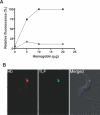Hemoglobin is a co-factor of human trypanosome lytic factor
- PMID: 17845074
- PMCID: PMC1971115
- DOI: 10.1371/journal.ppat.0030129
Hemoglobin is a co-factor of human trypanosome lytic factor
Abstract
Trypanosome lytic factor (TLF) is a high-density lipoprotein (HDL) subclass providing innate protection to humans against infection by the protozoan parasite Trypanosoma brucei brucei. Two primate-specific plasma proteins, haptoglobin-related protein (Hpr) and apolipoprotein L-1 (ApoL-1), have been proposed to kill T. b. brucei both singularly or when co-assembled into the same HDL. To better understand the mechanism of T. b. brucei killing by TLF, the protein composition of TLF was investigated using a gentle immunoaffinity purification technique that avoids the loss of weakly associated proteins. HDL particles recovered by immunoaffinity absorption, with either anti-Hpr or anti-ApoL-1, were identical in protein composition and specific activity for T. b. brucei killing. Here, we show that TLF-bound Hpr strongly binds Hb and that addition of Hb stimulates TLF killing of T. b. brucei by increasing the affinity of TLF for its receptor, and by inducing Fenton chemistry within the trypanosome lysosome. These findings suggest that TLF in uninfected humans may be inactive against T. b. brucei prior to initiation of infection. We propose that infection of humans by T. b. brucei causes hemolysis that triggers the activation of TLF by the formation of Hpr-Hb complexes, leading to enhanced binding, trypanolytic activity, and clearance of parasites.
Conflict of interest statement
Figures







Similar articles
-
African trypanosomes: intracellular trafficking of host defense molecules.J Eukaryot Microbiol. 2007 Jan-Feb;54(1):18-21. doi: 10.1111/j.1550-7408.2006.00228.x. J Eukaryot Microbiol. 2007. PMID: 17300512
-
The trypanolytic factor of human serum: many ways to enter the parasite, a single way to kill.Mol Microbiol. 2010 May;76(4):806-14. doi: 10.1111/j.1365-2958.2010.07156.x. Epub 2010 Apr 1. Mol Microbiol. 2010. PMID: 20398209 Review.
-
Membrane permeabilization by trypanosome lytic factor, a cytolytic human high density lipoprotein.J Biol Chem. 2009 May 15;284(20):13505-13512. doi: 10.1074/jbc.M900151200. Epub 2009 Mar 26. J Biol Chem. 2009. PMID: 19324878 Free PMC article.
-
Serum resistance-associated protein blocks lysosomal targeting of trypanosome lytic factor in Trypanosoma brucei.Eukaryot Cell. 2006 Jan;5(1):132-9. doi: 10.1128/EC.5.1.132-139.2006. Eukaryot Cell. 2006. PMID: 16400175 Free PMC article.
-
Mutual self-defence: the trypanolytic factor story.Microbes Infect. 2008 Jul;10(9):985-9. doi: 10.1016/j.micinf.2008.07.020. Epub 2008 Jul 12. Microbes Infect. 2008. PMID: 18675374 Review.
Cited by
-
Role of expression site switching in the development of resistance to human Trypanosome Lytic Factor-1 in Trypanosoma brucei brucei.Mol Biochem Parasitol. 2012 May;183(1):8-14. doi: 10.1016/j.molbiopara.2011.12.004. Epub 2011 Dec 29. Mol Biochem Parasitol. 2012. PMID: 22226682 Free PMC article.
-
Cytosolic peroxidases protect the lysosome of bloodstream African trypanosomes from iron-mediated membrane damage.PLoS Pathog. 2014 Apr 10;10(4):e1004075. doi: 10.1371/journal.ppat.1004075. eCollection 2014 Apr. PLoS Pathog. 2014. PMID: 24722489 Free PMC article.
-
Analysis of expressed sequence tags from the four main developmental stages of Trypanosoma congolense.Mol Biochem Parasitol. 2009 Nov;168(1):34-42. doi: 10.1016/j.molbiopara.2009.06.004. Epub 2009 Jun 25. Mol Biochem Parasitol. 2009. PMID: 19559733 Free PMC article.
-
Mono-allelic epigenetic regulation of polycistronic transcription initiation by RNA polymerase II in Trypanosoma brucei.mBio. 2025 Feb 5;16(2):e0232824. doi: 10.1128/mbio.02328-24. Epub 2024 Dec 20. mBio. 2025. PMID: 39704500 Free PMC article.
-
A co-evolutionary arms race: trypanosomes shaping the human genome, humans shaping the trypanosome genome.Parasitology. 2015 Feb;142 Suppl 1(Suppl 1):S108-19. doi: 10.1017/S0031182014000602. Parasitology. 2015. PMID: 25656360 Free PMC article. Review.
References
-
- Hoare CA. The Trypanosomes of mammals. A zoological monograph. Oxford: Blackwell Scientific Publications; 1972.
-
- Gibson W. Will the real Trypanosoma brucei rhodesiense please step forward? Trends Parasitol. 2002;18:486–490. - PubMed
-
- Gibson WC. Will the real Trypanosoma b. gambiense please stand up. Parasitol Today. 1986;2:255–257. - PubMed
-
- Pays E, Vanhamme L, Perez-Morga D. Antigenic variation in Trypanosoma brucei: Facts, challenges and mysteries. Curr Opin Microbiol. 2004;7:369–374. - PubMed
-
- Hajduk SL, Hager K, Esko JD. High-density lipoprotein-mediated lysis of trypanosomes. Parasitol Today. 1992;8:95–98. - PubMed
Publication types
MeSH terms
Substances
Grants and funding
LinkOut - more resources
Full Text Sources
Other Literature Sources
Molecular Biology Databases
Miscellaneous

